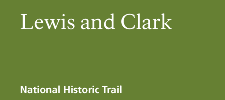|
1. How long does it take to travel the trail?
It varies depending on your mode of travel and the number of sites you hope to see along the Trail. To see the entire Lewis and Clark NHT, from Wood River, Illinois to the Pacific Ocean would require at least two or three weeks. Learn more about sites along the Trail from this map.
2. Where can I get a map of the Trail?
To request a Trail map, please contact Trail headquarters.
3. How many people were in the Corps of Discovery? Over the course of the Expedition, 59 people and one dog participated. Only thirty-three people (and one dog), however, left Fort Mandan, North Dakota and made the trip to the Pacific Ocean. Members of the Expedition included military men, engages (French men hired to work as boatmen or hunters), a slave, a Shoshoni woman, a baby, and a French trader.
4. How many died on the Expedition?
Only one member of the Corps of Discovery, Sergeant Floyd, died during the expedition. His death occurred near present day Sioux City, Iowa. Evidence indicates that he died of appendicitis.
5. How long was the Expedition?
It took the Corps of Discovery two years, four months and ten days to travel from their winter camp near St. Louis, to the Pacific Ocean, and back again to St. Louis. They left Camp Dubois, near St. Louis, on May 14, 1804 and arrived at the Pacific Ocean in early November of 1805. Returning to St. Louis required far less time. The Corps departed Fort Clatsop on March 23, 1806 and arrived in St. Louis on Sept. 23, 1806.
6. I've noticed a triangular sign at many sites along the Trail. What does it mean?
This symbol is found at certified sites along the Lewis and Clark National Historic Trail. Sites that are open to the public and that offer significant information about the Lewis and Clark Expedition are eligible for certification by the National Park Service. Learn more about certified sites.
7. How long is the trail?
The route from St. Louis to the Pacific Ocean is approximately 3,700 miles. The total distance traveled from St. Louis, to the Pacific Ocean, and back to St. Louis is just over 7,000 miles.
| 





